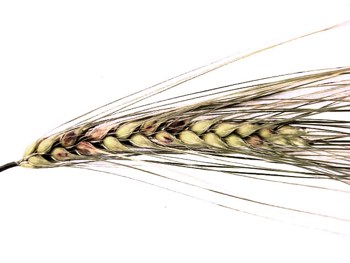Diseases
Several fungi in the genus Fusarium: F.graminearum, F. culmorum, F. avenaceum, F. poae, F. sporotrichioides. - Head Blight of barley.
Systematic position.
Fusarium spp. belong to imperfect fungi, class Deuteromycetes, order Moniliales, family Tuberculariaceae, genus Fusarium.Biological group.
Hemibiotrophic parasites.Morphology and biology.
The disease symptoms occur on diseased heads as a dark-brown color of spikelets. Damaged seeds are brown-green. Sometimes such seeds have thin coating of pink-salmon mycelia and conidia. All Fusarium species have one common taxonomic feature, i.e., production of distinctly shaped macroconidia (20-70 um) with different number of septae. The fungi over-winter by mycelium and chlamydospores in infected plant debris and seeds. Such species as F. graminearum may form teleomorph stage, which persists in crop residue and inoculates plants in the next period of vegetation. Spores are capable of producing infection, if they fall on heads of barley, beginning from flowering till harvesting. Spores are spread by wind over long distances, infecting other cereal crops.Ecology.
The infection favors humid and warm weather during and after heading.Distribution.
Fusarium Head Blight is widely distributed where barley is grown. In Russia epidemics of FHB occur often in the North Caucasus, NW Russia, and the Far East (at least every 2nd or 3rd year the percent of damaged seeds is higher than 5%). In central part of Russia, Ural, Baltic countries, South-West of Ukraine, Byelorussia this disease occurs sporadically, associated with years when suitable wet conditions for flowering and forming ears take place. In another part of the Russian territory the Fusarium fungi occur in a complex of pathogens of barley seeds. Middle Asia and Kazakhstan are too dry for scab development.Economic significance.
Damaged barley seeds are generally lightweight, having significant reductions in grain quality. Such seeds lack vitality and succumb to seedling blight. The growth of the Fusarium fungi in scabbed seeds promotes production of toxic compounds (mycotoxins) that are harmful to human and animal health. For the Fusarium Head Blight control the following actions are used. Cereal crops and corn are rotated with at least one-year break in grain cultivation. Complete covering of crop residues helps in reduction of fusarium infections. Use pf adapted barley varieties sown into a fertile, well-prepared seed bed. No resistant varieties of barley are available, but some varieties are tolerant to the disease. Treatment of seeds before sowing can reduce the level of infection. The spraying of rye by fungicides is not successful.Reference citations:
Buga S.F. 1999. Treatments of seeds by fungicides is the first step in protection of cereal crops against diseases. Zashchita zernovykh kul.tur. Minsk. V. 4: 4. (In Russian)Gagkaeva T.Yu. 2003. Importance of Fusarium Head Blight in Russia and the search for new sources of genetic resistance in wheat and barley. In: Canty S.M., Lewis J. & R.W. Ward, eds. Proceedings of the National Fusarium Head Blight Forum; 2003 Dec 13-15; Minesota, USA. 219-222 pp.
Levitin M., Ivashchenko V., Shipilova N., Nesterov A.N., Gagkaeva T., Potorochina I.G., Afanasyeva O.B. 1994. Pathogens of Fusarium Head Blight and forms of its appearance in North-western region of Russia. Mikologiya i fitopatologiya, 28(3): 58-64. (In Russian)
Piryazeva E.A. 2001. Sanitary mycological characters of grain forage in Ural and West-Siberian Regions of Russia. Ph.D. Thesis. Moscow. 18 p. (In Russian)
Shipilova N.P. 1994. Fusarium species composition and bioecological properties of pathogens of fusariosis on cereals. Ph.D. Thesis. St. Petersburg. 22 p. (In Russian)
Shipilova N., Gagkaeva T. 1992. Fusarium Head Blight on cereal crops in the North-western region of Russia. Zashchita rastenii, 11: 7-8. (In Russian)
© Gagkaeva T.Yu.


